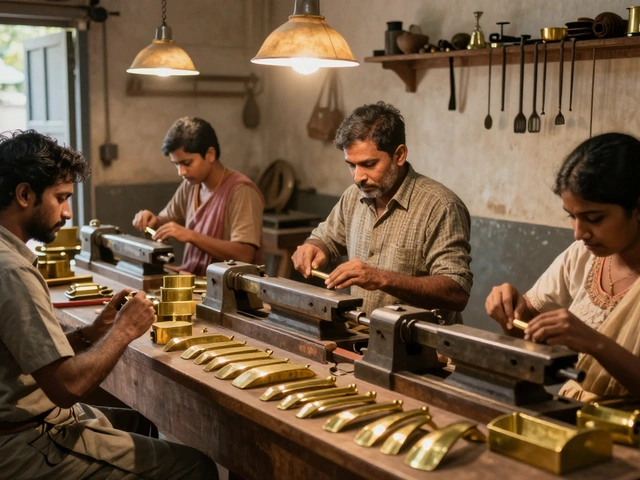How to Set Up a Small Factory: Step-by-Step Guide for Beginners

Building a small factory might sound overwhelming, but thousands of people start manufacturing businesses every year—on surprisingly modest budgets. The trick is to keep it focused and not get lost in endless planning.
Ever wondered why some local factories seem to thrive while others vanish in a few months? The difference usually comes down to two things: picking the right product, and setting up with just what you need to get started—not more, not less. This approach saves cash and gets you making sales faster.
You don’t need a giant building or brand-new machines to make your first sale. In fact, most successful small factories started with second-hand equipment and a rented workshop. The goal is simple: get something running, figure out what works, and grow from there. Don’t obsess over planning a perfect factory; focus on building a basic version that runs well from day one.
- Find the Right Product and Market
- Choose a Location and Plan Layout
- Get the Equipment and Legal Setup
- Build a Team and Start Operations
Find the Right Product and Market
The first move in setting up a small factory is picking the right thing to make. Forget fancy ideas—go for something simple, in demand, and realistic for your budget. Think about everyday products: food packaging, plastic parts, cleaning supplies, or simple electronics. These categories never go out of style because people use them every day.
It’s smart to look beyond just what you like and focus on what actually sells. A walk around your local market can give you tons of ideas. Notice which products fly off shelves and which just sit there. Better yet, talk to shop owners or buyers. They're usually happy to tell you what’s hard to get or always in demand.
One useful trick: start with products you’re already familiar with or those you’ve seen others successfully manufacture in your area. If there's a gap in your city—say, everyone imports disposable cups or metal parts—investigating why can open real business chances. Sometimes it’s about price, sometimes quality, sometimes just convenience.
- Check what items are imported into your city or area in bulk—these are usually hot opportunities for local manufacturing business.
- Look up trade data on small manufacturing goods for your state or country. In 2024, government websites in India and Southeast Asia posted lists of "Most Imported Items"—worth checking out.
- Join local business WhatsApp groups, Facebook groups, or visit small trade shows. These spots are gold mines for discovering what buyers and shop owners are currently hunting for.
Keep in mind, your first product doesn’t have to be flashy or high-tech. Even in 2025, products like paper bags, LED bulbs, and plastic containers still launch successful new factory setup stories, because local buyers always want reliable suppliers who deliver on time.
Choose a Location and Plan Layout
Picking where to put your small factory setup is a big deal. Location affects costs, how fast you get supplies, and even how easy it is to find workers. You don’t need a fancy address—what matters is being close to suppliers or customers and having space that fits your needs without breaking the bank.
A lot of beginners get stuck on this step, worried that renting a bigger space will help them grow faster. Actually, most seasoned factory owners recommend starting small. For example, in India, renting an industrial shed can cost as little as Rs. 10,000 per month in the outskirts of a city, but the same space in the city center could cost three times more without offering extra benefits for manufacturing work.
Before you sign anything, check the building’s power supply, water availability, and basic safety rules. If you deal with food or chemicals, make sure the spot meets government safety and zoning norms. Skipping these checks can lead to headaches later, like fines or forced shutdowns.
- Look for easy transport access: Is there a good road outside? Can delivery trucks turn around?
- Check if the rental is regular industrial property (not residential)—it saves you from legal trouble down the line.
- Think about expansion. Is there an empty plot next door if you outgrow your current space?
After you lock in the location, plan your factory layout before moving in any machines. Draw a simple sketch showing where every major machine and worktable will go. Spacing is key—make sure there’s enough room for people to move and for materials to flow from start to finish.
- Keep noisy or messy machines away from storage areas.
- Store finished products near the exit so loading trucks is faster.
- Place offices or administrative space in a spot where you can see the workshop but not be distracted by it all day.
If space is tight, vertical stacking for storage racks can double your available area. You can even visit small factories in your area to see what layouts work well for your specific manufacturing business.
| City | Outskirts | City Center |
|---|---|---|
| Delhi | $0.40 | $1.00 |
| Chennai | $0.30 | $0.85 |
| Pune | $0.35 | $0.90 |
Remember, your factory planning doesn’t have to be perfect the first time. Get the flow right, leave some room to adjust as you learn, and don’t overpay for space you don’t need yet. The right setup saves time, money, and headaches as your business grows.

Get the Equipment and Legal Setup
Time to talk tools, machines, and paperwork—stuff that can make or break your small factory setup. If you get the gear wrong, costs shoot up fast. Go too fancy and you’re broke before day one. Settle for junk and nothing works right. Here’s how to nail it.
First, make a list of everything you absolutely need for production. Check what similar businesses use. For example, if you’re opening a packaging factory, start with basics like sealing machines, cutters, and maybe one labeling machine. Used equipment saves tons of money; platforms like IndiaMart, Alibaba, or even local classified sites are goldmines. Don’t skip on maintenance history—reliable second-hand stuff often outperforms a brand-new, cheap import.
Here’s a quick breakdown of common equipment costs for typical starter factories:
| Factory Type | Key Equipment | Estimated Cost (USD) |
|---|---|---|
| Paper Bags | Bag making machine | 2,000 - 8,000 |
| Food Processing | Pulverizer, mixer, packaging unit | 4,000 - 12,000 |
| Plastic Products | Injection molding machine | 7,000 - 20,000 |
After the gear, legality can’t be ignored. Registering your manufacturing business makes you look legit and keeps authorities off your back. Start by picking a business structure—sole proprietorship is easiest for one person, while an LLP or Private Limited Company offers more credibility if you want to raise funds later.
- Get your factory registered with your local government or the state’s industrial department.
- Apply for a trade license from the municipal corporation.
- Register for GST (Goods and Services Tax). Without this, clients and suppliers might not take you seriously.
- If you have employees and machinery, you usually need basic workplace safety and pollution control certificates. Grab a checklist from the nearest MSME (Micro, Small & Medium Enterprises) office or look up their official website—most documents are pretty standard now.
Avoid shortcuts. Skipping registration is risky—it’ll bite you when you’re ready to scale up or sell to big companies. And don’t forget insurance. A fire, flood, or accident can wreck your business overnight. You can often get basic equipment and liability coverage bundled at decent rates.
Treat this step like building your car’s engine—do it right, and your manufacturing business will run smoother and faster when those first orders roll in.
Build a Team and Start Operations
Getting the right people on your side is what actually makes your small factory setup run. You don't need a huge staff at the start—a handful of reliable folks who can multitask is perfect. For most manufacturing business ideas, you’ll want:
- One or two skilled machine operators
- A helper for general tasks: moving raw material, packing finished goods
- If you’re not handling it, someone to sort out paperwork and accounts
Don’t just hire anyone. Experience helps, but trust and willingness to learn is just as valuable. A lot of factory owners say their best employees were people who started with zero direct experience but jumped in and figured things out fast.
Keep roles flexible at first. Your operators might need to pack boxes; your assistant might need to keep track of orders. This cuts costs and helps your team learn every side of the operation. If folks understand the whole process, mistakes go down and productivity shoots up.
"In my experience, training people across different tasks early on pays off later. Nobody gets stuck, and if someone is sick or quits, work never stops," says Kaushik Sharma, manager of a successful small garment factory in Ahmedabad.
Shift to operations: once equipment is delivered, set up a simple, clear workflow. Arrange your machines so that material moves easily from one step to the next—no shuffling back and forth. Stick up cheat-sheets or flowcharts near each machine for quick reference. This saves time and helps new people learn fast.
It’s normal to hit hurdles that you can’t predict from a plan. In the first month, expect little problems: a part gets stuck, a supplier misses a delivery, a worker calls in sick. Tackle each one head-on and keep notes. Actual ground-level experience shapes your factory way better than theories do.
Track your output right from the very first week. Use a spreadsheet or simple whiteboard—even a paper notebook—showing inputs, number of units made, and rejected items. This isn’t just for record-keeping. You’ll spot patterns: which shift works faster, which part of the factory planning needs more attention, or if a certain machine slows down everyone else.
| Sample Weekly Output Tracker | Units Produced | Units Rejected |
|---|---|---|
| Week 1 | 2,000 | 120 |
| Week 2 | 2,300 | 90 |
This kind of simple data tracking is what helps small factories survive and grow. You can’t improve if you don’t measure.
Finally, remember: people talk. Treat your team fairly and pay on time. In cities like Ludhiana and Surat, it’s common for good workers to recommend their friends—helping you find solid people as you grow.





